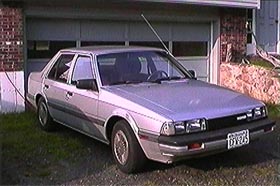The End?

It's been over two years now since I finished the EV and it's still running great. We typically use it for commuting to work, running quick errands, or going to the movies. It has seen two winters and performed well, although in the depths of winter when the thermometer dips below zero the range is less, but still adequate for our commute.
At one point I calculated that our average charging cost ranged from 25 to 40 cents a day. Every month or so we top off the batteries with distilled water. Yes, I have looked into those caps that turn the gases back into water, but considering that I would need 72 of them and since they cost at least $7 each it would cost me $500 just to avoid this "watering". No thanks...
Had a couple minor problems over the past couple of years. The Bycan offboard charger got zapped somehow (after the pack was fully charged) and I ended up sending the circuit board back to the company for repair. The folks at Bycan have provided very good support and otherwise the unit "just works". Send me an email if you are interested in buying my Bycan charger, I have found that I use the Zivan almost exclusively now. Why? Well, it is small enough that I could fit it onboard. I rarely ever need a "quick" charge. I don't park in the garage during spring, summer, and fall so it's easier to charge using the 110v Zivan (I don't have an outside 220 plug nor is my Bycan installed where it would be easy to charge an outside vehicle). None of these are failings of the Bycan, just realities of my particular setup. The Bycan will work off of 110 or 220, comes with a handful of temperature sensors, equalizes with a flip of a switch, and can be set up for a variety of pack voltages. Noel Perrin, Vermont EV enthusiast and author of Solo, has his Bycan mounted onboard with a nice setup so it can be used to charge from 110 or 220 volts AC, depending on what's available.
Oh, the other problem was that I had a few batteries which I let the water get low in. This partially exposed the plates, which isn't good for their longevity. I had been checking a couple "test" cells under the hood to determine how the water useage was. This had been a pretty reliable indicator, but this spring it turned out that some other cells were using more water than my test cells. Another lesson learned. I think I have another year on these batteries at which point I think it will be fun to see what new and improved choices I have. There are some exciting new batteries out already.
What else? Well, I'm starting to itch for another conversion. This time a lighter, more streamlined vehicle, maybe even a homebuilt one. Always wanted to try fiberglass. We'll see.
I certainly learned a lot with this car and there's always more to learn. The biggest thing that I personally learned is that I don't need an EV which gets 100 or 200 miles of range. Too often I have the burning urge to buy or make things that do absolutely everything. You know, the fastest computer with every option just in case I decide to become a multimedia author. A winter jacket that can be turned inside out to become formal attire. Whatever. In reality what our EV allow us to do is drive locally and be protected from the elements; with plenty of space for the dog, groceries, and a passenger or two. It won't win the Indy 500 (but it keeps up with other commuters), I don't drive it for my yearly vacation, and I don't go cruise mainstreet all evening. But it does provide transportation for over 400 trips in a year, well over 5,000 miles worth. It's not slow or embarassing to drive, in fact hardly anyone notices (passengers included) that it's an EV.